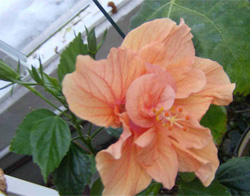Last summer, in one of those impulse buys, I purchased a tropical hibiscus. This is the showier cousin of the hardy ones that grow in our area. The flowers are five petalled, single, semi-doubled or full doubles. Many of the hybrids are exotically colored including just about every color of the spectrum except black. A sure sign that you have a tropical hibiscus is if it is a shade of orange or yellow or is multicolored.
The origin of this plant is Asia and the Pacific Islands and in North America it is only hardy to zone 9 or 10. While the tropical hibiscus will tolerate some light frost, the dropping of the thermometer to 25 degrees will generally result in its demise. These plants do not like cold, wet soil and will languish as night time temperatures dip into the forties.
My plant bloomed fairly well this summer as the center piece of a bed that contains a variety of bulbs and perennials. I intended to let the frost take it this fall because over wintering large potted plants is space consuming and frequently frustrating. Its life was saved by Lorraine who insisted that hers did quite well indoors in the winter.
I potted it up in the fall and dragged it inside. It started to drop its leaves but continued to bloom sporadically for quite some time. Finally, it dropped all of its leaves and sat there looking forlorn. Since it is in the greenhouse with as good light and humidity as I can give it the case seemed hopeless.
This month it is covered with buds and has produced 3 blossoms. New leaves are finally sprouting. The salmon colored blossoms only last one day but they are a cheerful addition at this time of the year. Thank you Lorraine for saving its life.
